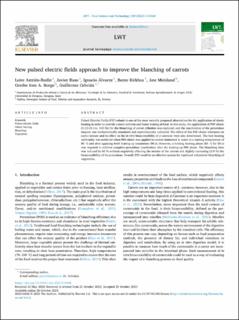| dc.contributor.author | Astráin-Redín, Leire | |
| dc.contributor.author | Raso, J. | |
| dc.contributor.author | Álvarez, Ignacio | |
| dc.contributor.author | Kirkhus, Bente | |
| dc.contributor.author | Meisland, Ane | |
| dc.contributor.author | Borge, Grethe Iren Andersen | |
| dc.contributor.author | Cebrián, Guillermo | |
| dc.date.accessioned | 2023-11-23T07:53:57Z | |
| dc.date.available | 2023-11-23T07:53:57Z | |
| dc.date.created | 2023-11-09T15:36:24Z | |
| dc.date.issued | 2023 | |
| dc.identifier.citation | Lebensmittel-Wissenschaft + Technologie. 2023, 189 1-13. | |
| dc.identifier.issn | 0023-6438 | |
| dc.identifier.uri | https://hdl.handle.net/11250/3104227 | |
| dc.description.abstract | Pulsed Electric Fields (PEF)-ohmic is one of the most recently proposed alternatives for the application of ohmic heating in order to provide a more uniform and faster heating of food. In this study, the application of PEF-ohmic (1.33 kV/cm, 100 Hz) for the blanching of carrot cylinders was explored, and the inactivation of the peroxidase enzyme was mathematically simulated and experimentally validated. The effect of this PEF-ohmic treatment on carrot texture and its effect on the in vitro bioaccessibility of β-carotene were also determined. The best heating uniformity was achieved when PEF-ohmic was applied to carrots immersed in water at a starting temperature of 80 °C and after applying brief heating-up treatments (90 s). However, a holding heating phase (85 °C for 50 s) was required to achieve complete peroxidase inactivation after the heating-up PEF phase. The blanching time was reduced by 60 % without negatively affecting the texture of the carrots and slightly increasing (3.9 %) the bioaccessibility of the β-carotene. Overall, PEF could be an effective system for rapid and volumetric blanching of vegetables. | |
| dc.language.iso | eng | |
| dc.title | New pulsed electric fields approach to improve the blanching of carrots | |
| dc.title.alternative | New pulsed electric fields approach to improve the blanching of carrots | |
| dc.type | Peer reviewed | |
| dc.type | Journal article | |
| dc.description.version | publishedVersion | |
| dc.source.pagenumber | 1-13 | |
| dc.source.volume | 189 | |
| dc.source.journal | Lebensmittel-Wissenschaft + Technologie | |
| dc.identifier.doi | 10.1016/j.lwt.2023.115468 | |
| dc.identifier.cristin | 2194742 | |
| dc.relation.project | Norges forskningsråd: 314599 | |
| dc.relation.project | Nofima AS: 202101 | |
| dc.relation.project | Nofima AS: 12307 | |
| dc.relation.project | Norges forskningsråd: 281106 | |
| cristin.ispublished | true | |
| cristin.fulltext | original | |
| cristin.qualitycode | 1 | |
